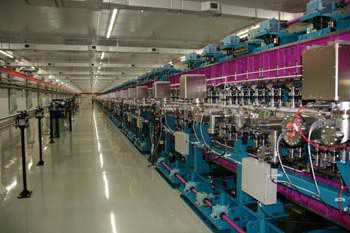Lasing Achieved at SACLA, X-ray Free Electron Laser Facility
| XFEL Research and Development Division RIKEN SPring-8 Center, RIKEN Harima Institute |
 |
| Undulator beamline, a laser amplifier part of SACLA(SPring-8 Angstrom Compact free-electron LAser) Photo by courtesy of RIKEN |
A beam of X-ray laser light with a wavelength of 1.2 Angstroms has been produced at SACLA (SPring-8 Angstrom Compact free-electron LAser), Japan’s first X-ray free-electron laser (XFEL) facility in Harima.
SACLA has been constructed since 2006, next to the SPring-8 storage ring in Harima, as a collaborative five-year project of RIKEN and the Japan Synchrotron Radiation Research Institute (JASRI). After its completion in March 2011, beam commissioning efforts aimed to achieve laser power amplification in the X-ray region. After only three months, at 4:10 pm on June 7, SACLA succeeded in producing, in SASE (Self-Amplified Spontaneous Emission) mode, a beam of X-ray laser light with the shortest wavelength yet achieved (1.2 Angstroms).
Fine system tuning to generate a stable X-ray laser with a higher intensity and shorter wavelength at a 60 Hz repetition rate will continue in the months ahead, and the facility will be opened to both domestic and international public users by the end of fiscal 2011.
SACLA is the world’s first XFEL designed to be as compact as possible using some of Japan’s unique high technology, such as a thermionic electron gun with a single-crystal cathode, a low-emittance injector, a high-gradient C-band RF acceleration system, and a short-period in-vacuum undulator. Producing the world’s shortest laser wavelength at SACLA proved the merit of the SPring-8 Compact SASE Source (SCSS), which is a new design concept adopted for SACLA.
Researchers at SACLA believe that this success will lead other countries to seriously consider building XFEL facilities based on the SCSS scheme, just as the huge third-generation synchrotron radiation sources (SPring-8, ESRF, APS) caused a shift towards medium-sized 3.5 generation devices (SOLEIL, SLS, DIAMOND) using short-period in-vacuum undulators as main light sources.
